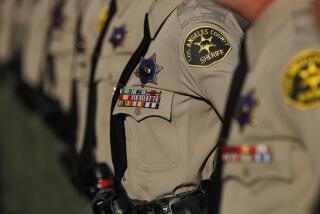Earning That Badge Isn’t Easy
- Share via
Before they hit the streets, Los Angeles County sheriff’s reserves hit the books. Level I reserves such as Jeff Zacha and Robert Kenneally must go through 409 hours of training at the sheriff’s training academy in Whittier. They learn everything from how to handle domestic disturbances to proper handcuffing technique and firearms training. The academy training is followed by 200 hours of field training and an additional 200 hours of in-service work.
After completing their training, reserve deputies are issued a badge, identification card and a service revolver. Then the real work begins. They must volunteer a minimum of 20 hours per month--16 hours of shift duty plus four hours of meetings. While on duty, reserve deputies have the same authority as regular deputies. Off duty, they may not carry a concealed weapon without a state permit.
The Long Beach Police Department also relies on a corps of reserve officers. The department’s 99 Level I reserves complete 320 hours of training and share the same duties as regular officers. The reserves are required to volunteer two shifts a month, a total of 20 hours. They also must attend six hours of additional training a month to learn about changes in laws and department procedures.
The Police Department hopes to double the number of Level I reserves in five years to help bolster the sworn police force, said Sgt. Richard Montoya, the reserve coordinator.
Sgt. Frank Decker, who trains reserve deputies for the Sheriff’s Department, says those who make it through the academy are a special breed. “The reserves are a great source of pride and a substantial asset,” Decker said. “They bring in a lot of expertise from their civilian professions.”
More to Read
Sign up for Essential California
The most important California stories and recommendations in your inbox every morning.
You may occasionally receive promotional content from the Los Angeles Times.










